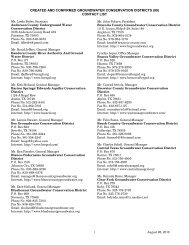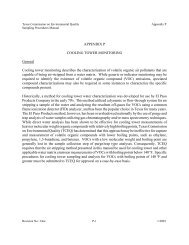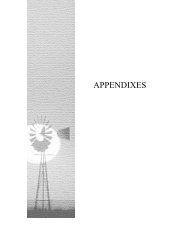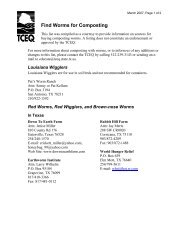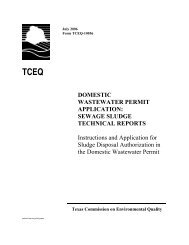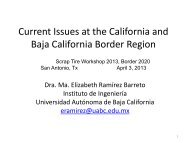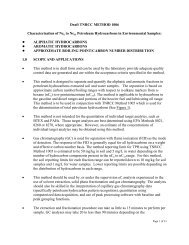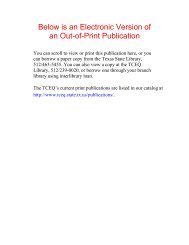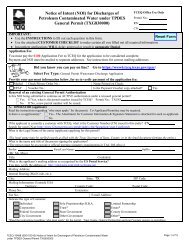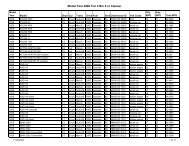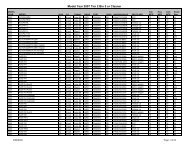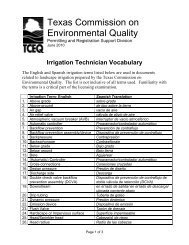Ecoregions of Texas, AS-199 - Texas Commission on Environmental ...
Ecoregions of Texas, AS-199 - Texas Commission on Environmental ...
Ecoregions of Texas, AS-199 - Texas Commission on Environmental ...
You also want an ePaper? Increase the reach of your titles
YUMPU automatically turns print PDFs into web optimized ePapers that Google loves.
ABSTRACT<str<strong>on</strong>g>Ecoregi<strong>on</strong>s</str<strong>on</strong>g> denote areas <str<strong>on</strong>g>of</str<strong>on</strong>g> general similarity in ecosystems and in the type, quality, and quantity <str<strong>on</strong>g>of</str<strong>on</strong>g>envir<strong>on</strong>mental resources. Ecoregi<strong>on</strong> frameworks are valuable tools for envir<strong>on</strong>mental research, assessment,management, and m<strong>on</strong>itoring <str<strong>on</strong>g>of</str<strong>on</strong>g> ecosystems and ecosystem comp<strong>on</strong>ents. They have been used for settingresource management goals, developing biological criteria and establishing water quality standards. In acooperative project with the <str<strong>on</strong>g>Texas</str<strong>on</strong>g> <str<strong>on</strong>g>Commissi<strong>on</strong></str<strong>on</strong>g> <strong>on</strong> Envir<strong>on</strong>mental Quality, the U.S. Envir<strong>on</strong>mental Protecti<strong>on</strong>Agency, the U.S. Department <str<strong>on</strong>g>of</str<strong>on</strong>g> Agriculture, and other interested state and federal agencies, we have definedecological regi<strong>on</strong>s <str<strong>on</strong>g>of</str<strong>on</strong>g> <str<strong>on</strong>g>Texas</str<strong>on</strong>g> at two hierarchical levels that are c<strong>on</strong>sistent and compatible with the U.S. EPAecoregi<strong>on</strong> framework. Twelve level III ecoregi<strong>on</strong>s and 56 level IV ecoregi<strong>on</strong>s have been mapped for <str<strong>on</strong>g>Texas</str<strong>on</strong>g>.These general purpose regi<strong>on</strong>s are useful to help structure and implement ecosystem management strategiesacross federal agencies, state agencies, and n<strong>on</strong>governmental organizati<strong>on</strong>s that are resp<strong>on</strong>sible for differenttypes <str<strong>on</strong>g>of</str<strong>on</strong>g> resources within the same geographical areas. Aquatic biologists in <str<strong>on</strong>g>Texas</str<strong>on</strong>g> have a l<strong>on</strong>g history <str<strong>on</strong>g>of</str<strong>on</strong>g>analyzing streams and potential reference c<strong>on</strong>diti<strong>on</strong>s within a variety <str<strong>on</strong>g>of</str<strong>on</strong>g> <str<strong>on</strong>g>Texas</str<strong>on</strong>g> regi<strong>on</strong>al frameworks. Thisecoregi<strong>on</strong> framework was the result <str<strong>on</strong>g>of</str<strong>on</strong>g> input from a variety <str<strong>on</strong>g>of</str<strong>on</strong>g> disciplines, both terrestrial and aquatic based,and takes a broader ecological perspective than just water quality or aquatic macroinvertebrates. We believethat this new ecoregi<strong>on</strong> framework still provides a valuable tool for the State’s water quality assessments.Streams that are representative <str<strong>on</strong>g>of</str<strong>on</strong>g> an ecoregi<strong>on</strong> and are minimally disturbed and least impacted from pointand n<strong>on</strong>point source polluti<strong>on</strong> can serve as suitable reference streams. <str<strong>on</strong>g>Ecoregi<strong>on</strong>s</str<strong>on</strong>g> and reference watershedscan be used together to better understand regi<strong>on</strong>al variati<strong>on</strong>s in stream quality, assess attainable c<strong>on</strong>diti<strong>on</strong>s,develop biological criteria, and augment the watershed management approach.ACKNOWLEDGEMENTSMany people c<strong>on</strong>tributed to the organizati<strong>on</strong> <str<strong>on</strong>g>of</str<strong>on</strong>g> this project and to the development <str<strong>on</strong>g>of</str<strong>on</strong>g> the <str<strong>on</strong>g>Texas</str<strong>on</strong>g> ecoregi<strong>on</strong>framework. For their collaborati<strong>on</strong> and c<strong>on</strong>tributi<strong>on</strong>s, special thanks are given to Anne Rogers (TCEQ), BillHarris<strong>on</strong> (TCEQ), Stephen Hatch (<str<strong>on</strong>g>Texas</str<strong>on</strong>g> A&M University), David Bezans<strong>on</strong> (Natural Area Preservati<strong>on</strong>Associati<strong>on</strong>), Jeffrey Comstock (Indus Corporati<strong>on</strong>), Philip Crocker (USEPA), Art Crowe (TCEQ), MichaelGolden (NRCS), Susan Casby-Hort<strong>on</strong> (NRCS), James Greenwade (NRCS), C<strong>on</strong>rad Neitsch (NRCS), ShannenChapman (Dynamac Corporati<strong>on</strong>), Augie De La Cruz (TCEQ), Kevin Wagner (<str<strong>on</strong>g>Texas</str<strong>on</strong>g> State Soil and WaterC<strong>on</strong>servati<strong>on</strong> Board [TSSWCB]), Richard Egg (TSSWCB), Alan Woods (Oreg<strong>on</strong> State University), ClarkHubbs (University <str<strong>on</strong>g>of</str<strong>on</strong>g> <str<strong>on</strong>g>Texas</str<strong>on</strong>g>), David Certain (The Nature C<strong>on</strong>servancy) and Thomas Loveland (USGS). Thesepeople were authors or collaborators <str<strong>on</strong>g>of</str<strong>on</strong>g> the multi-agency <str<strong>on</strong>g>Texas</str<strong>on</strong>g> ecoregi<strong>on</strong> poster published by the USGS(Griffith et al., 2004). Thanks are also given to the reviewers <str<strong>on</strong>g>of</str<strong>on</strong>g> the ecoregi<strong>on</strong> poster, including CharlesHallmark (<str<strong>on</strong>g>Texas</str<strong>on</strong>g> A&M University), Gord<strong>on</strong> Linam (TPWD), Milo Pyne (NatureServe), and Raym<strong>on</strong>dTelfair, II (TPWD).To obtain larger, color maps <str<strong>on</strong>g>of</str<strong>on</strong>g> the Level III and IV ecoregi<strong>on</strong>s <str<strong>on</strong>g>of</str<strong>on</strong>g> <str<strong>on</strong>g>Texas</str<strong>on</strong>g> or for an ARC/INFO export file <str<strong>on</strong>g>of</str<strong>on</strong>g> theecoregi<strong>on</strong> boundaries, c<strong>on</strong>tact the authors or see www.epa.gov/wed/pages/ecoregi<strong>on</strong>s/tx_eco.htm.ii<str<strong>on</strong>g>Ecoregi<strong>on</strong>s</str<strong>on</strong>g> <str<strong>on</strong>g>of</str<strong>on</strong>g> <str<strong>on</strong>g>Texas</str<strong>on</strong>g>



